Flying Insects
Wasps
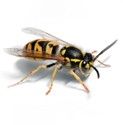
Wasps are colonial insects which live in social groups. These groups can contain many thousands of individuals or workers.
They feed on nectar, sweet materials, and at certain times, insect larvae and other animal pieces.
Queens that have survived the winter in sheltered places such as outbuildings and inside hollowed out trees emerge in early spring and build a small starter nest from paper.
This paper is made by mixing wood and saliva.
She will raise the initial brood herself, before the first workers emerge as adults and take over feeding and caring for the eggs produced by the queen.
Wasps can cause alarm when present in large numbers and in places where a nest can interfere with humans.
Wasps are capable of inflicting multiple painful stings and injecting venom to which severe allergic reactions and sometimes death can occur.
Wasp nests can usually be destroyed by the application of a residual insecticide, with the method of application and the formulation used, dependent on the location of the nest.
Bluebottles
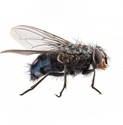
These flies all belong to a group of flies which are primarily scavengers which also includes Flesh flies and Blowflies
They lay their eggs on fish, meat decaying matter of animal origin and on open wounds of animals and man.
They will also lay eggs on faeces and decaying vegetable matter.
Larvae emerge from these eggs and feed on whatever material they have been laid upon, before crawling away to pupate and emerge as adult flies.
Such flies present a significant threat to human health by their means of feeding.
The adult fly will land on uncovered foodstuffs and vomit its stomach contents, which contain digestive enzymes, on to the foodstuff and then lap it up through its mouthparts.
The fly’s habit of feeding on rotting meat or faecal matter means that it carries pathogens on and in its body. These pathogens can then be passes to human food when the fly feeds on food intended for human consumption.
Control methods for these flies primarily consist of identifying the breeding site.
Residual insecticides can be applied and electronic fly killers can be particularly effective, however attention to hygiene issues is the key to controlling this pest.
Houseflies
There are 2 main species of housefly
1. Common housefly
2. Lesser housefly
Although named the housefly, these flies can be found almost anywhere where a suitable food source and breeding materials can be found.
These flies lay eggs on and in moist, decaying or putrefying materials such as excrement and rotting vegetable matter.
Houseflies are potential vectors of diseases such as dysentery, gastroenteritis, and tuberculosis. They can also transmit intestinal worms.
When feeding, they will move from filth to food indiscriminately and may therefore move pathogens from dirty to clean areas.
Control methods are greatly enhanced by paying particular attention to hygiene standards to reduce potential feeding and breeding sites.
It should be noted these flies can and will travel up to 5 miles to find new feeding areas so the flies on a premises may not have necessarily originated in that location.
In this instance the application of insecticides and the installation of fly killers can help.
Cluster Flies
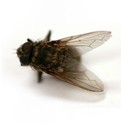
Cluster flies are a pest of buildings and dwellings, overwintering in roof voids and around window frames, emerging when raised temperatures are detected.
They can occur in large numbers in roof voids
Because of their large size Cluster flies are commonly mistaken for bluebottles.
Adult females lay their eggs at the entry to earthworm burrows, the larvae then emerge and enter the body of the earthworm and consume it from within.
The larvae then pupate in the soil and emerge as the adult.
They are not considered a threat to human health; however they can present a significant nuisance when they emerge in the spring and are unable to escape outside.
Treatments for these flies are relatively straightforward and generally involve the application of a suitable insecticide.
Fruit Flies
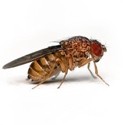
As the name suggests, fruit flies are associated with waste fruit.
Eggs are laid on rotting fruits and it is here the larvae emerge to feed.
Fruit flies will also breed on spillages of fruit juices and concentrates as well as being attracted to alcohol with high sugar contents.
They are not considered a threat to human health; however they can present a significant nuisance threat, especially in premises serving food and drink.
Control methods are greatly enhanced by paying particular attention to hygiene standards to reduce potential feeding and breeding sites.
Bumble Bees
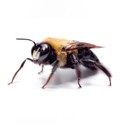
Bumble Bees are colonial insects which live in social groups.
They feed on nectar, pollen and other sweet materials.
Each nest is usually built underground and is started by a single queen who will often use an old mouse hole as a place to build a nest, although bumble bee nests have been found in a variety of locations such as abandoned birds’ nests, barns, grass cuttings and compost heaps.
As the summer months progress, the bee numbers expand rapidly with successive generations of workers becoming larger as the food supply improves.
Although they do possess a sting, bumble bees are in fact very docile and will only sting when greatly provoked.
After the honey bee, bumble bees as the 2nd most important pollinators of plants.
Bumble bees rarely cause humans any problems but workers can occasionally be aggressive necessitating treatment of the nest.
Bumble bee numbers have fluctuated over the last 30 years so any decision to destroy a colony should not be taken lightly.
Honey Bees
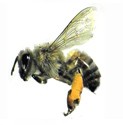
Honey bees are colonial insects which live in complex, highly organized social groups. These groups can contain many thousands of individuals or workers, each with a specific job within the nest. These jobs range from tending to the queen and the larvae to building and expanding the nest and foraging for food.
Honey bee nest differ from wasps nests in that they do not die off in the winter months.
When a nest becomes too crowded, the old queen will leave and take around half of the workers with her to form a new nest. This behavior can be observed at certain times of the year and is known as “swarming”.
Honey bees traditionally build nests in hollowed out trees or such like, but will take advantage of cavity wall gaps.
Honey bees possess a venomous sting and will readily defend their nests.
Some humans are hypersensitive to the venom in these stings to the extent that a sting can be life threatening.
Honey bee numbers have dropped significantly in the last 10 years due mainly to a condition known as Honey Bee Colony Collapse Disorder.
The exact cause of this condition is largely unknown.
The destruction of honey bee nests should always be a last resort.
Affected premises where the presence of a nest is causing alarm should firstly contact a bee keeper to remove the nest and relocate it to a more suitable habitat.
Honey bees are not a protected species and destruction of nests can be carried out, however this is a particularly specialist procedure and professional help should be sought.
Masonry Bees
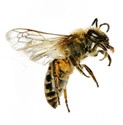
Masonry bees, as the name suggests, are bees who commonly build nests in soft or damaged materials such as mortar and the like.
Masonry Bees are not true social bees but many may be found next to each other as they exploit suitable nesting sites.
The damage caused by these bees to good mortar is often greatly exaggerated.
These bees only exploit poor and damaged mortar to build small single chamber nests in which their larvae are reared.
They are extremely unlikely to sting and their presence only constitutes a slight nuisance.
The only long term solution to these bees is to repoint he affected area or in the case of defective stonework, replace or remove it.
Moths
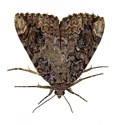
There are countless species of moth in the world, but relatively few are considered a pest species.
Moths are the adult stage of a group of insects which are known to infest products or raw materials of both plant and animal origin.
Moths are most regularly associated with attacking woolen materials but are most common in the production of food where they will infest almost all stored foods and raw materials.
The adults will lay eggs on various raw materials, dependent on species. When they hatch the larvae will consume the raw material, pupate and then emerge as adults.
Moths can become a major pest in the food industry as they can infest batches of raw materials resulting in spoilage which renders the material unfit for human consumption.
Control of moths calls for early detection of adults and can lead to long and complex procedures to eradicate them.





